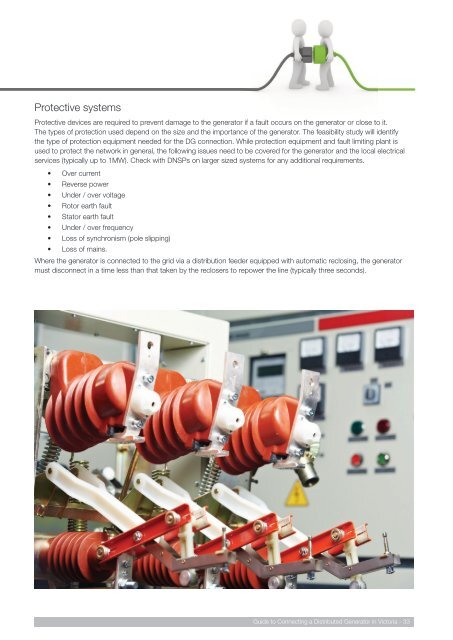Guide to Connecting a Distributed Generator - Sustainability Victoria
Guide to Connecting a Distributed Generator - Sustainability Victoria
Guide to Connecting a Distributed Generator - Sustainability Victoria
You also want an ePaper? Increase the reach of your titles
YUMPU automatically turns print PDFs into web optimized ePapers that Google loves.
Protective systemsProtective devices are required <strong>to</strong> prevent damage <strong>to</strong> the genera<strong>to</strong>r if a fault occurs on the genera<strong>to</strong>r or close <strong>to</strong> it.The types of protection used depend on the size and the importance of the genera<strong>to</strong>r. The feasibility study will identifythe type of protection equipment needed for the DG connection. While protection equipment and fault limiting plant isused <strong>to</strong> protect the network in general, the following issues need <strong>to</strong> be covered for the genera<strong>to</strong>r and the local electricalservices (typically up <strong>to</strong> 1MW). Check with DNSPs on larger sized systems for any additional requirements.• Over current• Reverse power• Under / over voltage• Ro<strong>to</strong>r earth fault• Sta<strong>to</strong>r earth fault• Under / over frequency• Loss of synchronism (pole slipping)• Loss of mains.Where the genera<strong>to</strong>r is connected <strong>to</strong> the grid via a distribution feeder equipped with au<strong>to</strong>matic reclosing, the genera<strong>to</strong>rmust disconnect in a time less than that taken by the reclosers <strong>to</strong> repower the line (typically three seconds).<strong>Guide</strong> <strong>to</strong> <strong>Connecting</strong> a <strong>Distributed</strong> Genera<strong>to</strong>r in Vic<strong>to</strong>ria - 33




